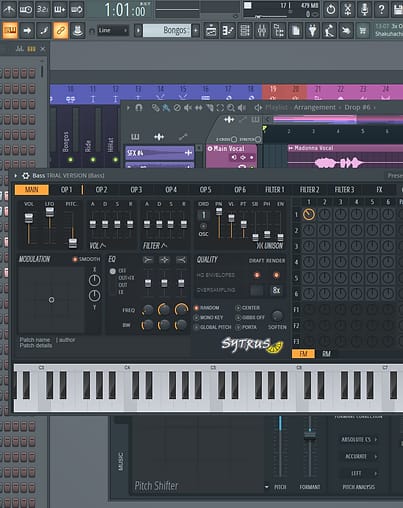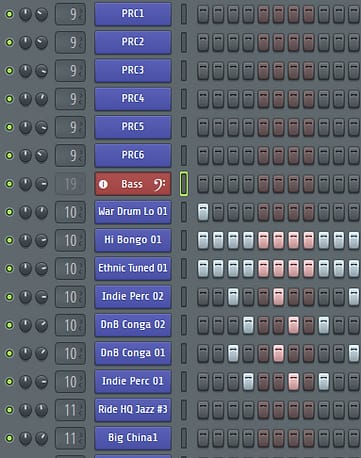

A full-featured music production environment, FL Studio allows for multi-track audio recording, sequencing, and mixing to produce music songs of professional calibre. You won’t be limited by a musical style thanks to powerful MIDI and ReWire compatibility, VST hosting, versatile mixing, and these features. Songs and loops can be exported in Fl Studio.

The first piece of advice to enhance your midi editing. The most effective approach to input midi notes is by utilising the draw tool, which you have probably heard of and possibly used.
How does FL Studio make loops?
Holding control while clicking and dragging your pointer across the main timeline area (where the measure numbers are) will allow you to construct a loop. Hold control while clicking the timeline to end the loop

Channels and instruments: In FL Studio, each channel has its own plugin for an instrument. Synthesizers or sample players are frequently employed as instruments in music to produce the melody and percussion. VST, AU (macOS), and FL Studio’s own native plugin formats are all supported by FL Studio.

FL Studio’s internal channels employ a scalar amplitude scheme with a 32-bit depth. Your sounds won’t clip within the programme as a result. Any overs, however, transform into clips the moment you export to a set bit depth, such as 16 or 24, or convert your 32-bit export to an mp3.
A plug-in, also known as an add-on or extension, is a piece of computer software that enables the addition of additional features without changing the host programme itself. Plug-ins, are extensively used in digital music, and video.

How to use the resources at your disposal to make a good mix is covered in this section. New producers frequently mix and master at the same time, which leads to confusion and unsatisfactory results. Similar to this, we see a lot of people on a never-ending search for “mastering” plugins that can instantly turn mixes into ‘professional’ sounds.

The final stage of music creation is mastering. It involves enhancing the perceived volume and sound quality of your song (if possible and/or necessary) using instruments like an equaliser, compressor, limiter, stereo enhancer, etc.
It also involves getting music ready for the right platform (i.e., “mastered for iTunes”). Your song should be ready for release after mastering.

Sameer Daate Sir is very experienced music singer and composer. who has worked from last three decade in Indian film industry and now for upgrading his skill for music production he is being continue with his Music Production Course in mumbai.
Surjeet Marwa is the professional DJ Based in Australia.who performed all over the world and to enhance his performing skill, he took the online and offline advance training program for Ableton Live.
Adya is a very good musician based in the UK and came to beatpro to learn the advance program for ableton.
Sandeep is the popular youtuber who achieved above 1 million subscribers through his guitar performing and teaching methods. Sandeep has done course Music Production for FL studio to make pro sound for his youtube work. https://www.youtube.com/channel/UC0h1SjZLR_D6KV3czLHN7Ew
Bali has been a professional guitar tutor and performer since 2005 based in mumbai. He has done the course for Push2 and ableton.
http://beatpro.in/ Online music production courses in mumbai. BeatPro the best music production academy in mumbai. BeatPro is having students for music production courses through out the India. People are coming to learn Music production to BeatPro. check out the link above to know more about music production courses and BeatPro.
For further information, kindly visit our academy: https://beatpro.in or https://onlinebeatpro.com
Contact No: 07506372004
Address: G-1, Evershine Apartments 2, Ground Floor, Plot No.142 A/B, 7 Bungalows, Andheri West, 400053, Maharashtra, India
Online music production courses l Music programming training l Music Programming courses l Online music programming courses in mumbai l Online music production courses in India l Online music training courses in Pune l Online music production training cources in Goa l Music programming courses in Delhi l How to learn Logic Pro l
http://beatpro.in/
Learn Music Programming in Mumbai_ Fruity Loops And Logic Pro X Courses. BeatPro Ville Parle (w)
Contact No. +91-7506372004
Learn online Logic Pro X and Fruity Loop Studio from BeatPro. We are offering you online Music Programming courses as well as Music Production Services. First time in Mumbai Beatpro is providing all Music Production Services online, BeatPro is a complete technology school for Music Production. Our Music Producers will provide you all you need for your songs music production. Take a step ahead to BeatPro for best result for your best creativity.
http://beatpro.in/ Online music production courses in mumbai. BeatPro the best music production academy in mumbai. BeatPro is having students for music production courses through out the India. People are coming to learn Music production to BeatPro. check out the link above to know more about music production courses and BeatPro.
For further information, kindly visit our academy: https://beatpro.in or https://onlinebeatpro.com
Contact No: 07506372004
Address: G-1, Evershine Apartments 2, Ground Floor, Plot No.142 A/B, 7 Bungalows, Andheri West, 400053, Maharashtra, India
Music Production Institute in Mumbai for EDM, Bollywood And Sound Designing.Classes would be taken in Mumbai. for more details please visit our website www.beatpro.in
Abhijit Pohankar is a famous face of Indian Modern Music , a keyboardist, an instrumentalist , a singer , a music producer who is best known for playing classical ragas on keyboard and has created an unique fusion of modern music with classical music. Abhijit Pohankar was born to famous classical vocalist Pandit Ajay Pohankar in the year 29th June 1975. From childhood, music became an integral part of his life and with all his hard work he has established a new name in the music industry with his own classical genre. https://www.youtube.com/user/pohankar